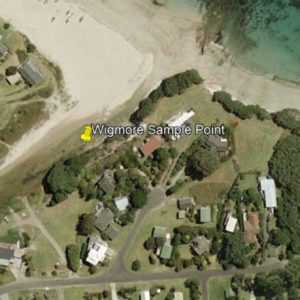Summary of Ecological Monitoring at Wigmore Stream (2024–2025)
Each year, the Hahei Wastewater Treatment Plant (WWTP) is independently monitored to assess its impact on the health of Wigmore Stream. This includes testing water quality and surveying stream life both upstream (before the discharge point) and downstream (after it).
You can read the full report here.
Key Findings (refer to Section 5: Discussion and Conclusions of the report)
- No measurable harm from the treatment plant: Monitoring indicates that the treated wastewater discharged into the stream does not cause ecological harm. Conditions upstream and downstream of the discharge point were broadly similar.
- Nutrient levels: Some nutrient levels (such as nitrogen and phosphorus) were slightly elevated downstream; however, these increases were modest and did not appear to impact aquatic life.
- Bacteria levels (E. coli): A key finding was that bacteria levels in the stream were significantly higher than those in the treated wastewater from the WWTP. In fact, the treated water was cleaner in this regard than the stream itself—both upstream and downstream of the discharge point. This strongly suggests that contamination is likely due to land use, particularly ageing septic tanks on properties adjacent to the stream—an issue commonly raised by the community.
- Stream life: The diversity and abundance of aquatic species in the stream remain limited, primarily due to natural factors such as tidal influence and soft sediment, rather than any effect from the WWTP.
Community Implications
These results reinforce growing concerns among Hahei residents that properties near Wigmore Stream should be prioritised for connection to the WWTP to reduce contamination risks and protect both stream and beach health. The existing treatment plant has sufficient spare capacity to service all adjacent properties, which should be connected as a priority.
Many in the community—ourselves included—believe the WWTP should be upgraded (i.e. its capacity increased) to allow all residential properties in Hahei, including future developments, to be connected. The first priority should be those properties with ageing septic systems.
What’s Next?
A new water quality monitoring point has been added on a side stream (upstream of the WWTP outlet) to help identify other potential pollution sources. The report also recommends that Thames-Coromandel District Council review public health signage, given the elevated bacteria levels—unrelated to the WWTP—which pose health risks, especially for swimming and shellfish collection in the estuary area.

